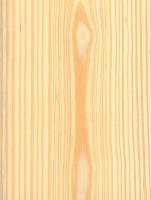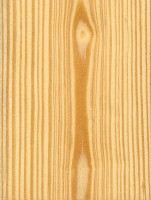 |
Common Name(s): Sumatran Pine, Merkus Pine Scientific Name: Pinus merkusii Distribution: Southeast Asia (primarily Indonesia) Tree Size: 100-130 ft (30-40 m) tall, 2-3 ft (.6-1 m) trunk diameter Average Dried Weight: 44 lbs/ft3 (710 kg/m3) Specific Gravity (Basic, 12% MC): .57, .71 Janka Hardness: 950 lbf (4,230 N) Modulus of Rupture: 13,980 lbf/in2 (96.4 MPa) Elastic Modulus: 2,161,000 lbf/in2 (14.90 GPa) Crushing Strength: 7,100 lbf/in2 (49.0 MPa) Shrinkage: Radial: 5.8%, Tangential: 8.8%, Volumetric: 14.6%, T/R Ratio: 1.5 |
Color/Appearance: Heartwood is light reddish brown, demarcated sapwood is pale yellow to nearly white. Color tends to darken with age.
Grain/Texture: Grain is straight, with a medium, even texture.
Rot Resistance: Heartwood is rated as non-durable to perishable regarding decay resistance. Sumatran Pine is also susceptible to termite/insect attack.
Workability: Overall, Sumatran Pine works fairly well with most tools, though the resin can gum up tools and clog sandpaper. Sumatran Pine glues and finishes well.
Odor: Sumatran Pine has a mild, resinous odor when being worked.
Allergies/Toxicity: Working with pine has been reported to cause allergic skin reactions and/or asthma-like symptoms in some people. See the articles Wood Allergies and Toxicity and Wood Dust Safety for more information.
Pricing/Availability: Frequently mixed with Khasi Pine and sold as construction lumber.
Sustainability: This wood species is not listed in the CITES Appendices, but is on the IUCN Red List. It is listed as vulnerable due to a population reduction of over 20% in the past three generations, caused by a decline in its natural range, and exploitation.
Common Uses: Paper (pulpwood), flooring, furniture, matchsticks, and construction lumber.
Comments: Sumatran Pine is the only true pine (Pinus genus) that has a natural distribution that is south of the equator. It is sometimes grown on plantations, not only for its lumber, but also for the copious amounts of resin which the trees produce.
- Austrian Pine (Pinus nigra)
- Caribbean Pine (Pinus caribaea)
- Eastern White Pine (Pinus strobus)
- Jack Pine (Pinus banksiana)
- Jeffrey Pine (Pinus jeffreyi)
- Khasi Pine (Pinus kesiya)
- Limber Pine (Pinus flexilis)
- Loblolly Pine (Pinus taeda)
- Lodgepole Pine (Pinus contorta)
- Longleaf Pine (Pinus palustris)
- Maritime Pine (Pinus pinaster)
- Ocote Pine (Pinus oocarpa)
- Patula Pine (Pinus patula)
- Pinyon Pine (Pinus edulis)
- Pitch Pine (Pinus rigida)
- Pond Pine (Pinus serotina)
- Ponderosa Pine (Pinus ponderosa)
- Radiata Pine (Pinus radiata)
- Red Pine (Pinus resinosa)
- Sand Pine (Pinus clausa)
- Scots Pine (Pinus sylvestris)
- Shortleaf Pine (Pinus echinata)
- Slash Pine (Pinus elliottii)
- Spruce Pine (Pinus glabra)
- Sugar Pine (Pinus lambertiana)
- Table Mountain Pine (Pinus pungens)
- Western White Pine (Pinus monticola)
- Virginia Pine (Pinus virginiana)
Scans/Pictures: There are currently no pictures of this exact wood species, but a similar species within the Pinus genus is being substituted (P. sylvestris). If you’d like to contribute a wood sample of this specific species to be scanned, (even small pieces of veneer can be sent), please use the contact form.
 |
 |





This wood is called “jati belanda” in Indonesian.
This is also sometimes called Mindoro Pine or Cambodian Pine. See https://erdb.denr.gov.ph/publications/rise/r_v23n1.pdf and https://wasonmalaysia.com/woodspecies-03.htm